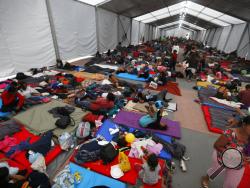MEXICO CITY (AP) — Thousands of Central Americans dreaming of getting to the United States streamed into Mexico's capital and bedded down in a sports stadium on the eve of U.S. midterm elections in which President Donald Trump has made the migrant caravan a central issue.
Authorities counted more than 2,000 migrants entering the Jesus Martinez stadium by midafternoon Monday, and a steady flow continued into the night. The facility has a capacity to hold 6,000, officials said, and four big tents set up for sleeping filled up.
Still hundreds of miles from the U.S. border, early arrivals eagerly sifted through donated clothes, gave themselves sponge baths and ate chicken and rice. They then picked up thin mattresses to hunker down for the night. Much in demand were blankets to ward off the chill in a city more than 7,300 feet (2,240 meters) above sea level, a big change after trudging for three weeks in tropical heat.
Nashieli Ramirez, ombudsman for the local human rights commission, said the city was preparing to accommodate as many as 5,000 people. The lead caravan is estimated to have about 4,000 participants and several smaller groups are trailing hundreds of miles to the south.
"We have the space in terms of humanitarian help," Ramirez said.
Many of the migrants sought treatment for blistered and aching feet, illness and other maladies. "Since we got here, we have not stopped," said Tania Escobar, a nurse with Mexico City's public health department at the treatment tent.
Melvin Figueroa, a 32-year-old from Tegucigalpa, Honduras, was with his pregnant wife and two children, 6 and 8. He took the 6-year-old girl to the tent because her eyes were irritated and "she throws up everything she eats."
More migrants were trudging along the highway between the city of Puebla and the capital, trying to hitch rides from passing vehicles.
Trump has seized on the caravan and portrayed it as a major threat, even though such caravans have happened regularly over the years and largely passed unnoticed. He ordered thousands of troops to the U.S.-Mexico border when the migrants were still hundreds of miles to the south, threatened to detain asylum seekers in tent cities and has insinuated without proof that there are criminals or even terrorists in the group.
In dozens of interviews since the initial caravan set out from Honduras more than three weeks ago, migrants have said they are escaping rampant poverty and violence. Many are families traveling with small children. Some say they left because they were threatened by gang members or had lost relatives to gang violence. Others say they hope to work, secure a good education for their children and send money to support loved ones back home.
Alba Zoleida Gonzalez, 48, from Valle, Honduras, said she walked for five hours Monday, then was able to get a ride on a tractor-trailer with about 150 other migrants. Her calf muscles were aching, but that was a small price to pay for the chance at a life better than the one back home.
"I looked for work, and nothing," Gonzalez said, adding that her husband had been robbed and had to hand over everything he made selling crabs so his assailants wouldn't do worse. "And when one does find a little job they kill you for the money," she said.
Arriving in Mexico City, some migrants visited the Basilica of Our Lady of Guadalupe, a major pilgrimage site, to thank the Virgin Mary for watching over them during the journey.
The caravan had spread out in recent days, with many participants advancing at a faster pace. Many said the caravan would now regroup in Mexico City. Oscar Ulloa, 20, an accountant from Honduras who was able to travel to the capital by bus from Puebla thanks to handouts from Mexicans, said he expected the group to vote in the coming days on its next moves.
The 178-mile (286-kilometer) route followed Monday to Mexico City from the city of Cordoba in the Gulf state of Veracruz was the longest single-day journey attempted by the group.
There were obstacles on this latest stretch. Truck after truck denied migrants rides as they trudged along the highway into the relatively colder November temperatures of central highland Mexico. Then migrants converged on tractor trailers, forcing the big rigs to stop so they could climb aboard. Such impromptu hitchhiking is precarious with dozens scrambling onto vehicles at a time.
Mexico City is more than 600 miles from the nearest U.S. border crossing at McAllen, Texas. A caravan last spring opted for a much longer route to Tijuana in the far northwest, across from San Diego. That caravan steadily dwindled to only about 200 people by the time it reached the border.
Many in the latest group said they remain convinced that traveling together is their best hope for reaching the U.S.
But Edgar Corzo, an official with the National Human Rights Commission, said that based on experiences with previous migrant caravans, the group probably will begin to break up now that it is in the capital.
"Each one goes to the place that he considers best," mainly wherever is closest to where they have relatives or friends already in the United States, he said.
___
By SONIA PEREZ D., MARK STEVENSON, and MARIA VERZA, Associated Press
___
Associated Press writer Amy Guthrie contributed to this report.

